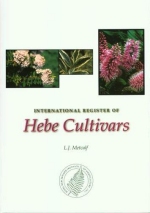BOOK REVIEWS
L. J. Metcalf, 232 pages, ISBN 0-9597756-4-1. Review by Bob Edwards
The first Hebe
cultivar register, a 15-year of labour of love and painstaking research
by native plantsman Lawrie Metcalf, is an extremely valuable reference
to over 800 cultivars produced from the 100 or so species, mostly
endemic to New Zealand. It is not complete, says Lawrie, noting the first species to be described was Hebe magellanica (South America) and that many hybrids and selections may have existed in France but have yet to be unearthed and he suspects a revision may be necessary in the future. He welcomes additional information and can be contacted at Greenwood, 179 Westdale Rd, RD1, Richmond, Nelson. The 232-page book also contains two general chapters: Hebe: Origins and Evolution by Professor Phil Garnock-Jones (Victoria University, Wellington), a useful modern background to the genus; and A History of Hebe as a Garden Plant by Dr Peter Heenan (Landcare Research, Lincoln), a thoroughly researched guide to 150 years of Hebe gardening and trade history. Both have excellent references that will be invaluable for students undertaking further work. Extensive indexes and cultivar descriptions Over 135 pages of cultivars and hybrids are listed together with their origins, descriptions (where available), references to journals, catalogues, indexes, papers where these have been found, synonyms, incorrect and invalid names, and in many cases additional notes and interpretation by the genera's International Registrar, the author. A separate alphabetical listing with cross references will assist readers through the maze and the 16 colour photos will make identification of some modern releases easier. The final chapter, a 4-page Heliohebe list, is a bonus. To those who tinker with names we suggest you read the entry for Hebe Eveline (introduced c.1893) and the headache this has caused. It has also been listed as Evelyn, Gauntlettii, Evalina, Gauntlette, speciosa Pink, Pink Payne, Rainers Beauty, Pink Lord, speciosa Gauntlettii, Pink and Pink Pearl. Emerald Gem and others have suffered a similar fate. To those who select, breed and release new Hebe cultivars: have them described properly, registered and written up to make the Registrar's job easier and ensure correct, detailed information is published quickly. Growers and retailers will find this Royal New Zealand Institute of Horticulture publication a valuable reference. It is the start to getting the correct cultivar names in circulation once and for all and a major effort is needed as the muddle existing in the trade and in gardens is considerable. Spelling also needs to be tidied. Hebe Margret is often written incorrectly as Margaret. The Registrar has not accepted the name Mary Antoinette for the blue hebe released by Annton Nurseries (Cambridge) as it's too similar to Marie Antoinette, a variety written up in The Floral World and Garden Guide in 1874, 112 years earlier. The number of lost cultivars and hybrids is of major concern. As there is no repository for Hebe cultivars and hybrids and as many of the hybrids now in circulation here and overseas are likely to go out of production due to rapidly changing trends and fashions, a pictorial reference is now urgent. The International Register of Hebe Cultivars is an impressive work, a must for everyone interested in the genus and an excellent companion to Douglas Chalk's Hebes and Parahebes, Lawrie's bibles and Flora of New Zealand volumes that contain additional information. Highly recommended. Available from The Royal New Zealand Institute of Horticulture |
Home | Journal
| Newsletter | Conferences
Awards | Join
RNZIH | RNZIH Directory | Links
© 2000–2026 Royal New Zealand Institute of Horticulture
Last updated: March 1, 2021


